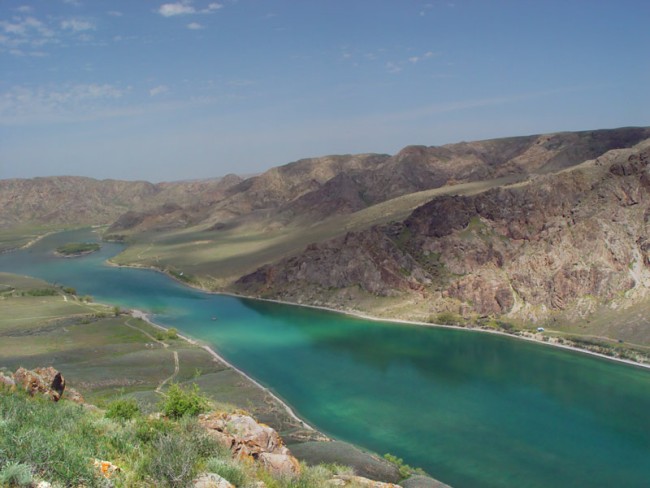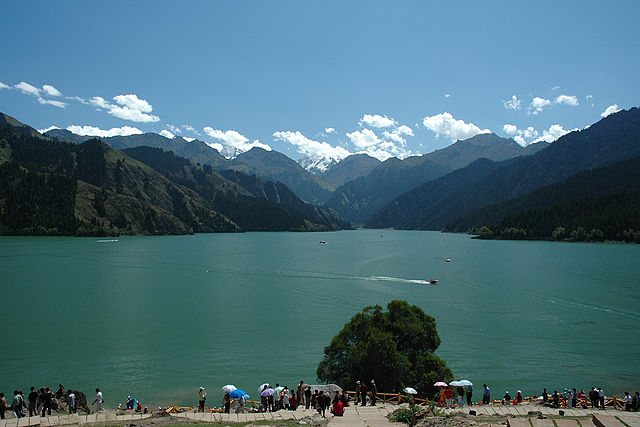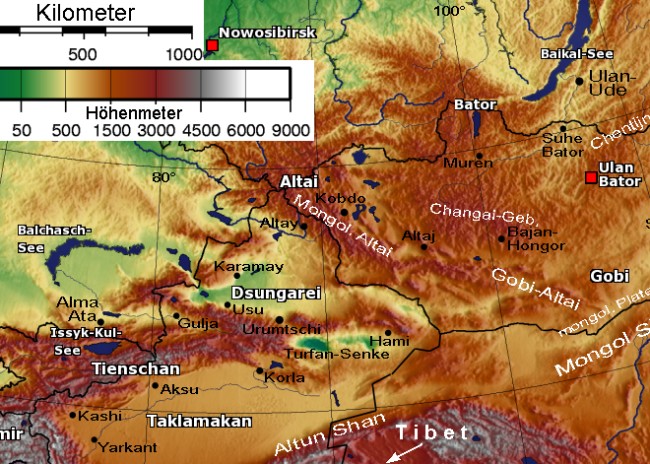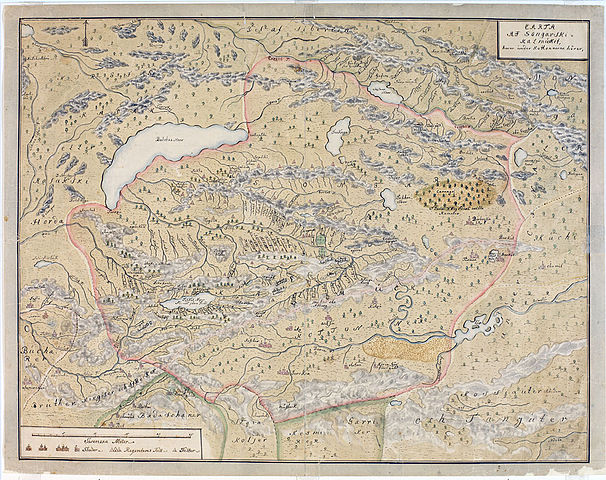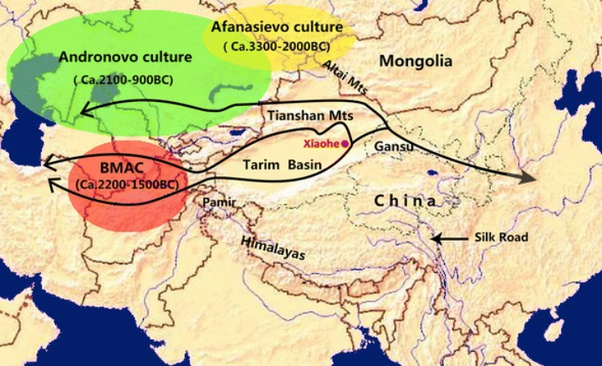
| DZUNGARIA
Ili River
Heaven Lake of Tian Shan
Kanas Lake
Bayanbulak Grassland Dzungaria (also spelled Zungaria, Dzungharia, Zungharia, Dzhungaria, Zhungaria, Djungaria, Jungaria or Songaria) is a geographical subregion in Northwest China corresponding to the northern half of Xinjiang, also known as Beijiang (Pinyin: Beijiang; lit.: 'Northern Xinjiang'). Bounded by the Tian Shan mountain range to the south and the Altai Mountains to the north, it covers approximately 777,000 km2 (300,000 sq mi), extending into Western Mongolia and Eastern Kazakhstan. Formerly the term could cover a wider area, conterminous with the Dzungar Khanate, a state led by the Oirats in the 18th century which was based in the area.
Although geographically, historically and ethnically distinct from the Turkic-speaking Tarim Basin area, the Qing dynasty and subsequent Chinese governments integrated both areas into one province, Xinjiang. As the center of Xinjiang's heavy industry, generator of most of Xinjiang's GDP, as well as containing its political capital Ürümqi ("beautiful pasture" in Oirat), Northern Xinjiang continues to attract intraprovincial and interprovincial migration to its cities. In comparison to southern Xinjiang (Nanjiang, or the Tarim Basin), Dzungaria is relatively well integrated with the rest of China by rail and trade links.
Etymology
:
Background :
Northern Xinjiang - Dzungharian Basin (yellow), Eastern Xinjiang - Turpan Depression (Turpan Prefecture and Hami Prefecture) (red), Southern Xinjiang - Tarim Basin (blue) Xinjiang consists of two main geographically, historically, and ethnically distinct regions, Dzungaria north of the Tianshan Mountains and the Tarim Basin south of the Tianshan Mountains, before Qing China unified them into one political entity called Xinjiang province in 1884. At the time of the Qing conquest in 1759, Dzungaria was inhabited by steppe dwelling, nomadic Tibetan Buddhist Dzungar people, while the Tarim Basin was inhabited by sedentary, oasis dwelling, Turkic speaking Muslim farmers, now known as the Uyghur people.
The Qing dynasty was well aware of the differences between the former Buddhist Mongol area to the north of the Tianshan and Turkic Muslim south of the Tianshan, and ruled them in separate administrative units at first. However, Qing people began to think of both areas as part of one distinct region called Xinjiang. The very concept of Xinjiang as one distinct geographic identity was created by the Qing and it was originally not the native inhabitants who viewed it that way, but rather it was the Chinese who held that point of view. During the Qing rule, no sense of "regional identity" was held by ordinary Xinjiang people; rather, Xinjiang's distinct identity was given to the region by the Qing, since it had distinct geography, history and culture, while at the same time it was created by the Chinese, multicultural, settled by Han and Hui, and separated from Central Asia for over a century and a half.
In the late 19th century, it was still being proposed by some people that two separate parts be created out of Xinjiang, the area north of the Tianshan and the area south of the Tianshan, while it was being argued over whether to turn Xinjiang into a province.
Dzungarian Basin :
Physical map showing the separation of Dzungaria and the Tarim Basin (Taklamakan) by the Tien Shan Mountains The core of Dzungaria is the triangular Dzungarian Basin, also known as Jungar Basin, or in Chinese as simplified Pinyin: Zhungá'er Péndì, with its central Gurbantünggüt Desert. It is bounded by the Tian Shan to the south, the Altai Mountains to the northeast and the Tarbagatai Mountains to the northwest. The three corners are relatively open. The northern corner is the valley of the upper Irtysh River. The western corner is the Dzungarian Gate, a historically important gateway between Dzungaria and the Kazakh Steppe; presently, a highway and a railway (opened in 1990) run through it, connecting China with Kazakhstan. The eastern corner of the basin leads to Gansu and the rest of China. In the south, an easy pass leads from Ürümqi to the Turfan Depression. In the southwest, the tall Borohoro Mountains branch of the Tian Shan separates the basin from the upper Ili River.
The basin is similar to the larger Tarim Basin on the southern side of the Tian Shan Range. Only a gap in the mountains to the north allows moist air masses to provide the basin lands with enough moisture to remain semi-desert rather than becoming a true desert like most of the Tarim Basin and allows a thin layer of vegetation to grow. This is enough to sustain populations of wild camels, jerboas, and other wild species.
The Dzungarian Basin is a structural basin with thick sequences of Paleozoic-Pleistocene rocks with large estimated oil reserves. The Gurbantunggut Desert, China’s second largest, is in the center of the basin.
The Dzungarian basin does not have a single catchment center. The northernmost section of Dzungaria is part of the basin of the Irtysh River, which ultimately drains into the Arctic Ocean. The rest of the region is split into a number of endorheic basins. In particular, south of the Irtysh, the Ulungur River ends up in the (presently) endorheic Lake Ulungur. The Southwestern part of the Dzungarian basin drains into the Aibi Lake. In the west-central part of the region, streams flow into (or toward) a group of endorheic lakes that include Lake Manas and Lake Ailik. During the region's geological past, a much larger lake (the "Old Manas Lake") was located in the area of today's Manas Lake; it was fed not only by the streams that presently flow toward it but also by the Irtysh and Ulungur, which too were flowing toward the Old Manas Lake at the time.
The cold climate of nearby Siberia influences the climate of the Dzungarian Basin, making the temperature colder—as low as -4 °F (-20 °C)—and providing more precipitation, ranging from 3 to 10 inches (76 to 254 mm), compared to the warmer, drier basins to the south. Runoff from the surrounding mountains into the basin supplies several lakes. The ecologically rich habitats traditionally included meadows, marshlands, and rivers. However, most of the land is now used for agriculture.
It is a largely steppe and semi-desert basin surrounded by high mountains: the Tian Shan (ancient Mount Imeon) in the south and the Altai in the north. Geologically it is an extension of the Paleozoic Kazakhstan Block and was once part of an independent continent before the Altai mountains formed in the late Paleozoic. It does not contain the abundant minerals of Kazakhstan and may have been a pre-existing continental block before the Kazakhstan Block was formed.
Ürümqi, Yining and Karamai are the main cities; other smaller oasis towns dot the piedmont areas.
Paleontology
:
•
Dsungaripterus
weii (pterosaur)
Ecology
:
The northeastern portion of the Dzungarian Basin semi-desert lies within Great Gobi National Park, and is home to herds of Onagers (Equus hemionus), goitered gazelles (Gazella subgutturosa) and Wild Bactrian camels (Camelus ferus).
The basin was one of the last habitats of Przewalski's horse (Equus przewalskii), also known as Dzungarian horse, which was once extinct in the wild, though it has since been reintroduced in areas of Mongolia and China.
History :
The first people to inhabit the region were Indo-European-speaking peoples such as the Tocharians in prehistory and the Jushi Kingdom in the first millennium BC.
Before the 21st century, all or part of the region has been ruled or controlled by the Xiongnu Empire, Han dynasty, Xianbei state, Rouran Khaganate, Turkic Khaganate, Tang Dynasty, Uyghur Khaganate, Liao dynasty, Kara-Khitan Khanate, Mongol Empire, Yuan Dynasty, Chagatai Khanate, Moghulistan, Qara Del, Northern Yuan, Four Oirat, Dzungar Khanate, Qing Dynasty, the Republic of China and, since 1950, the People's Republic of China.
One of the earliest mentions of the Dzungaria region occurs when the Han dynasty dispatched an explorer to investigate lands to the west, using the northernmost Silk Road trackway of about 2,600 kilometres (1,600 mi) in length, which connected the ancient Chinese capital of Xi'an to the west over the Wushao Ling Pass to Wuwei and emerged in Kashgar.
Istämi of the Göktürks received the lands of Dzungaria as an inheritance after the death of his father in the latter half of the sixth century AD.
Dzungaria is named after a Mongolian kingdom which existed in Central Asia during the seventeenth and eighteenth centuries. It derived its name from the Dzungars, who were so called because they formed the left wing (züün, left; gar, hand) of the Mongolian army, self-named Oirats. Dzungar power reached its height in the second half of the 17th century, when Galdan Boshugtu Khan repeatedly intervened in the affairs of the Kazakhs to the west, but it was completely destroyed by the Qing Empire about 1757–1759. It has played an important part in the history of Mongolia and the great migrations of Mongolian stems westward. Its widest limit included Kashgar, Yarkand, Khotan, the whole region of the Tian Shan, and the greater proportion of that part of Central Asia which extends from 35° to 50° N and from 72° to 97° E.
After 1761, its territory fell mostly to the Qing dynasty during the campaign against the Dzungars (Xinjiang and north-western Mongolia) and partly to Russian Turkestan (the earlier Kazakh state provinces of Zhetysu and Irtysh river).
After the Dzungar genocide, the Qing subsequently began to repopulate the area with Han and Hui people from China Proper.
The population in the 21st century consists of Kazakhs, Kyrgyz, Mongols, Uyghurs and Han Chinese. Since 1953, northern Xinjiang has attracted skilled workers from all over China—who have mostly been Han Chinese—to work on water conservation and industrial projects, especially the Karamay oil fields. Intraprovincial migration has mostly been directed towards Dzungaria also, with immigrants from the poor Uyghur areas of southern Xinjiang flooding to the provincial capital of Ürümqi to find work.
As a political or geographical term Dzungaria has practically disappeared from the map; but the range of mountains stretching north-east along the southern frontier of the Zhetysu, as the district to the southeast of Lake Balkhash preserves the name of Dzungarian Alatau. It also gave name to Djungarian hamsters.
Dzungaria
and the Silk Road :
Tarim Basin The difficulty with south side was the high mountains between the Tarim and Ferghana. There is also another reason. The Taklamakan is too dry to support much grass, and therefore nomads when they are not robbing caravans. Its inhabitants live mostly in oases formed where rivers run out of the mountains into the desert. These are inhabited by peasants who are unwarlike and merchants who have an interest in keeping trade running smoothly. Dzungaria has a fair amount of grass, few towns to base soldiers in and no significant mountain barriers to the west. Therefore, trade went south and migrations north. Today most trade is north of the mountains (Dzungarian Gate and Khorgas in the Ili valley) to avoid the mountains west of the Tarim and because Russia is currently more developed.
Economy
:
Dzungaria has deposits of coal, gold, and iron, as well as large oil fields.
Source :
https://en.wikipedia.org/ |

